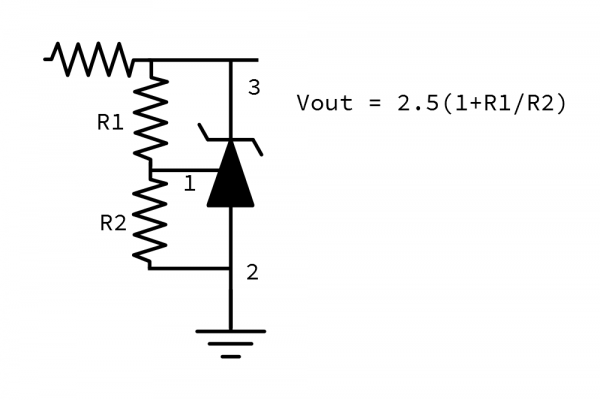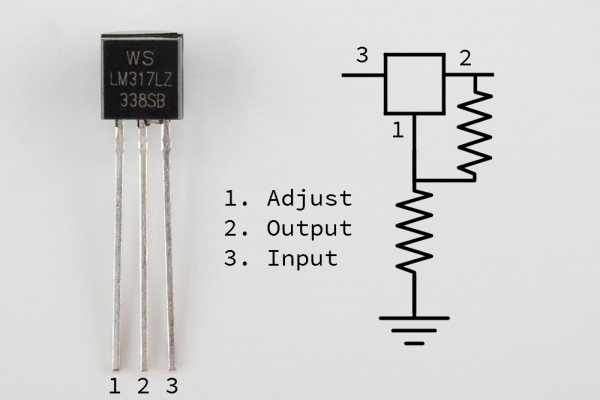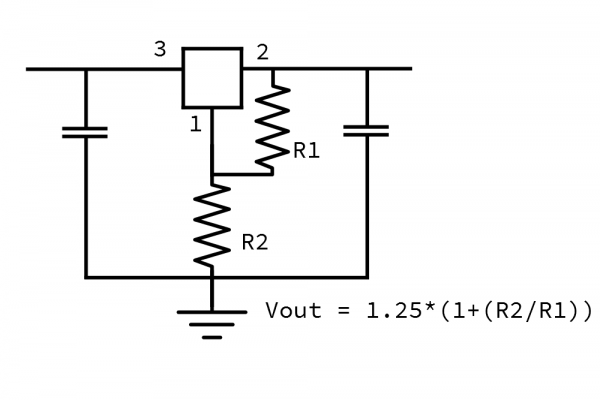Discrete Semiconductor Kit Identification Guide
Voltage Devices
We're actually cheating the definition of discrete a little bit with the next two components. They're both actually integrated circuits!
They're still in TO-92 packages, though. The first is actually a general purpose replacement for Zener diodes. The second is a voltage regulator -- again, not discrete, but very handy to have around.
TL431A Voltage Reference
When we were selecting parts for this kit, we thought it might be nice to have some Zener diodes -- but there was no agreement as to the Zener voltage. What we really wanted was an adjustable Zener Diode: enter the TL431A voltage reference. It functions similarly to a Zener diode, but the voltage is set using external resistors.
The output voltage can be varied between 2.5V and the power supply voltage, up to 36V. Like a Zener Shunt, it requires a resistor in series with the cathode.
Zener shunt circuits are useful when you want to generate a stable and constant voltage but the input voltage varies. For instance, the RedBoard can accept between 7 and 15VDC on its barrel jack. If we need to derive a stable reference voltage from that, that most obvious approach would be to use a voltage divider, but we'd find that the resulting voltage would vary in relation to the input voltage. A Zener shunt (or active voltage reference) is a way of deriving an input-independent reference voltage.
Polarity
The TL431A has three terminals, the reference voltage, anode, and cathode. The anode and cathode terminology is borrowed from Zener diodes.
This will make more sense as we explore the following examples.
Sample Circuits
The simplest TL431A circuit requires a single resistor on the cathode. The reference pin is tied to the cathode, and the output is taken from the cathode. The result is 2.5V at the cathode, regardless of the input voltage.
The input resistor shown in the diagram above needs to be selected to bias the TL431A with at least 1 mA. You can find a maximal value using the formula Rin = (Vin-Vout)/0.001. Typical applications use values between 150 Ω and 10KΩ For use as an unloaded voltage reference, the input resistor is relatively noncritical, though if significant current is being supplied, a smaller resistor will dissipate less power.
Varying the output voltage requires two more resistors.
You can make a variable voltage reference if you use a potentiometer for R1, as shown in Figure 10 of the datasheet.
The output of the TL431A is best suited as a reference for other circuitry (such as comparators or analog-to-digital converters), and not particularly suited for powering external circuitry. While it creates a stable output voltage, it requires the cathode resistor, which will dissipate heat if the load draws very much current. The adjustable voltage regulator is a similar integrated circuit that bypasses this limitation.
LM317L Voltage Regulator
The LM317L is similar to the TL431A, but it's intended to be used as part of a power supply.
You'll notice the marking on the part in the photo has an extra suffix of "Z", which indicates a TO-92 body, packaged as loose pieces (as opposed to on tape).
The configuration of the LM317L is also similar to the LT431A, with a pair of resistors setting the output voltage. You'll notice that it doesn't require a resistor on the input like the TL431A did.
In this circuit, it's worth noting the capacitors from the input to ground and the output to ground. The datasheet states
An input capacitor is not required, but it is recommended, particularly if the regulator is not in close proximity to the power-supply filter capacitors.
...
An output capacitor improves transient response, but it not needed for stability.
It goes on to recommend values of 0.1uF for the input capacitor, and 1uF for the output.
The LM317L is rated to supply up to 100 mA. If you need more current, consider stepping up the the LM317L's larger brother, the TO-220-cased LM317. If you add a large heatsink, you can draw significantly more current from it.




